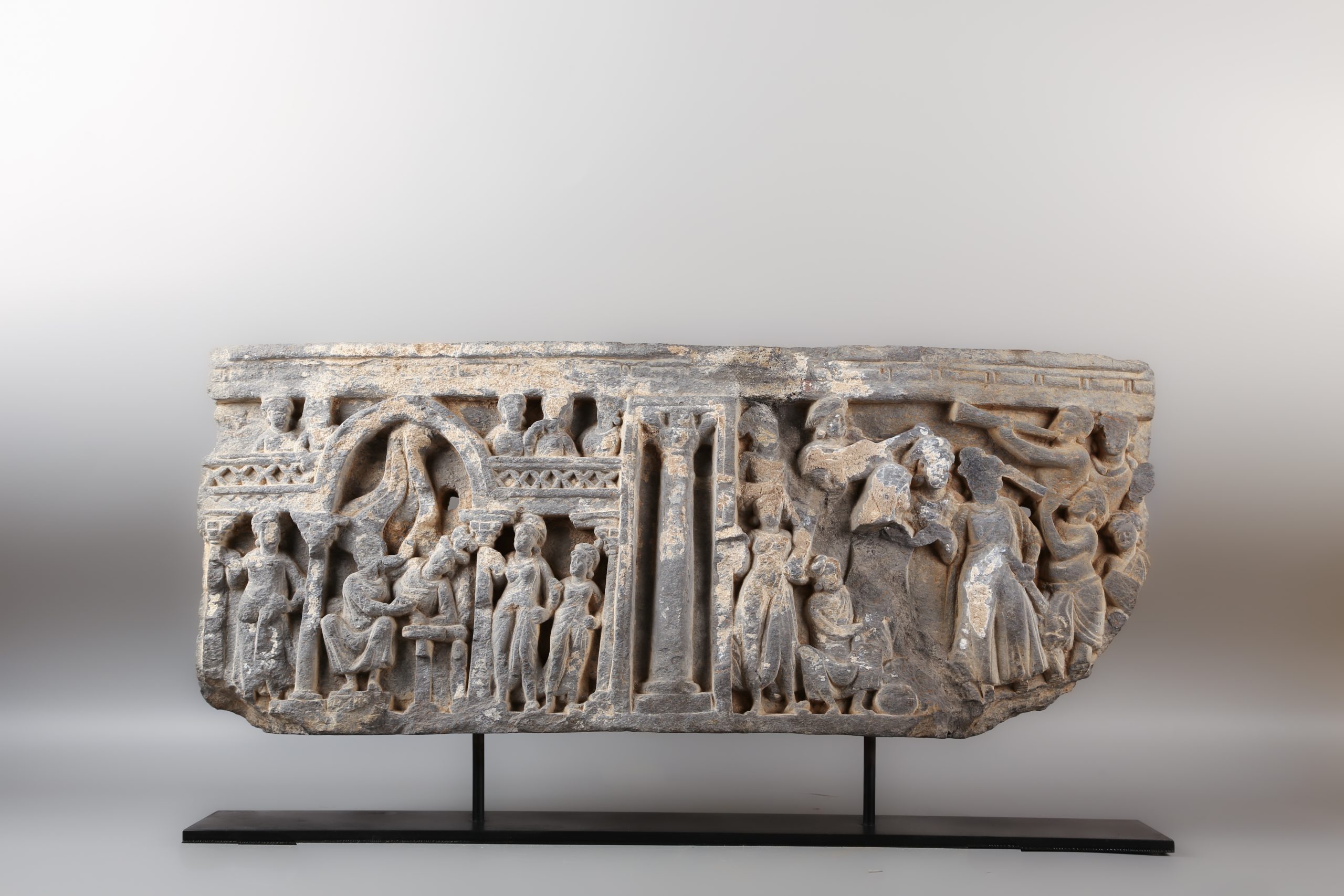The Marriage of Siddhārta
25 000,00€
Grey schist
Ancient region of Gandhāra
Circa 2nd-3rd century
L. 66 cm or 26 in
Description
A remarkable aesthetics
It is in the region of Gandhāra that the iconography of the Buddha in a human form is gradually being established. The school of Gandhāra focuses on the last existence of the historical Buddha, as well as on his past lives or jātaka. It develops a syncretic style, which can be seen in the presence of composite pilasters with acanthus motifs, a pattern used by the Greeks to allow the different moments of a narrative to be partitioned and highlighted, as is the case here. Moreover, the characters’ clothing bears witness to the Hellenistic and Roman stylistic influence, sometimes draped in broad clothing with quilted folds reminiscent of a toga or himation, sometimes the muscular torso left visible and covered with jewelry reminiscent of the nomadic ancestry of the Kuṣāṇ tribes (Guishuang, Yuezhi tribe that gave the term Kuṣāṇ). Halfway between the Indian sage, in the mode of monks, and the Indo-Greek prince of Apollonian type, the historical Buddha embodies the access to liberation or Enlightenment. The school of Gandhāra literally puts in image the texts of the Lalitavistara Sūtra or Divyāvadāna, testifying to his pedagogical and missionary fervor in the first centuries of the era.
Two rare scenes
Featuring two scenes probably inherited from the Lalitavistara Sūtra, mixing historical biography of the Buddha with marvelous wonders, one recognizes in the first scene on the left an architectural decoration with an Indian arch, similar to the monumental openings made in the facades of the great halls of the monasteries, built in the Mahārāṣṭra cliffs of northeast Deccan as of the 2nd century B.C.E. (e.g. Bhājā), and copied directly from real wooden structures. These arches are extended on both sides by balconies, frequently depicted in the art of Gandhāra. Small spectators watch the main scene: a central figure, wearing an elaborate turban, lies half-reclining on a couch and faces a woman sitting on his right. Above them are perhaps stylized garlands. On either side, assistants watch the scene. By comparison with a relief from the British Museum (1917,1009.5), this could be the representation of Siddhārta and his wife. The scene on the right shows a princely figure holding his sword in his left hand, while a woman in profile faces him. A figure stands behind them and musicians celebrate the scene. While identification cannot be asserted with certainty, it would be possible and consistent to see a rare depiction of the marriage of Siddhārta, which would also explain this scene of jubilation.
The art of narration in the region of Gandhāra
The Gandhāran monasteries had two types of areas: courtyards accessible to devotees and crowded with all sorts of ex-voto monuments, such as reliquary tumuli (stūpa) and chapels, and beyond that an area reserved only for monks. In the public areas, the bases of the stūpa, the door and window surrounds, the plinths and sometimes even the risers of the stairs bore numerous reliefs, juxtaposing decorative motifs and apologetic narrative scenes. The curved surface of this frieze indicates that it decorated a stūpa. The remarkable plasticity of the figures should be noted, entirely due to the virtuosity of the Gandhāran workshops using a grey-blue schist typical of the creative centers of northern Pakistan, in the Swāt valley for example.
Provenance: Collection Vérité, France.





